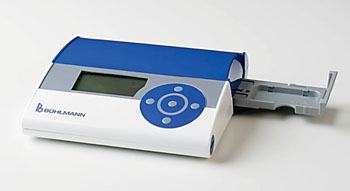Unnecessary Endoscopies Could Be Avoided with Fecal Blood Test
By LabMedica International staff writers
Posted on 14 Oct 2016
The majority of primary care patients referred for bowel endoscopy do not have significant colorectal disease (SCD), and are unnecessarily exposed to a small but realistic risk of severe endoscopy-associated complications.Posted on 14 Oct 2016
Serious colorectal diseases, including colorectal cancer, are difficult to diagnose as the signs and symptoms are not always clear. Any suspicion of SCD requires a general practitioner referral to a hospital for an endoscopy but studies have shown that between 60% to 80% of referred patients end up not having SCD.

Image: The Quantum Blue rapid test allow for the immediate measurement of fecal calprotectin (Photo courtesy of Bühlmann Laboratories).
Scientists at the University Medical Center Utrecht (Netherlands) collected data from the large-scale study where 810 patients suspected of SCD were enrolled from 266 primary care practices in the Netherlands. A pre-endoscopy venous blood sample was drawn to estimate hemoglobin and C-reactive protein (CRP) concentrations according to routine clinical practice. The team developed a diagnostic strategy to better exclude SCD in these patients and evaluated the value of adding a fecal calprotectin point-of-care (POC) and/or a POC fecal immunochemical test for hemoglobin (FIT-Hb)) to routine clinical information.
The investigators analyzed the fecal samples for calprotectin concentration by a quantitative point-of-care (POC) test (Quantum Blue; dynamic range 30 to 300 μg/g) and by an enzyme-linked immunosorbent assay (ELISA; EK-CAL Calprotectin ELISA, (both from Bühlmann Laboratories, Schönenbuch, Switzerland), both yielding estimates of μg calprotectin/g feces. For fecal Hb the team used a qualitative POC FIT, the Clearview iFOBT One Step Fecal Occult Blood Test Device, (Alere Health; Waltham, MA, USA), yielding either a positive or negative test result with a lower detection limit of 6 μg/g.
Out of the 810 patients referred for an endoscopy, 669 were found to have no SCD. Once the results of the FIT test had been taken into account the scientists found that approximately 30% of these patients could have been prevented from having an endoscopy as they may have been correctly diagnosed as not having SCD during their doctor’s visit. The study also looked at the benefit of adding a fecal test for the protein calprotectin to the diagnostic strategy. They found that this test also improved the diagnosis of SCD but not to the same extent as FIT. Furthermore, combining both tests added little extra benefit to the diagnostic accuracy of FIT alone.
The authors concluded that FIT and to a much lesser extent calprotectin POC testing showed incremental value for SCD diagnosis beyond standard clinical information. A diagnostic strategy with routine clinical data and a POC FIT test may safely rule out SCD and prevent unnecessary endoscopy referral in approximately one third of SCD-suspected primary care patients. The study was published on September 26, 2016, in the journal BMC Medicine.
Related Links:
University Medical Center Utrecht
Bühlmann Laboratories
Alere Health












.jpg)
